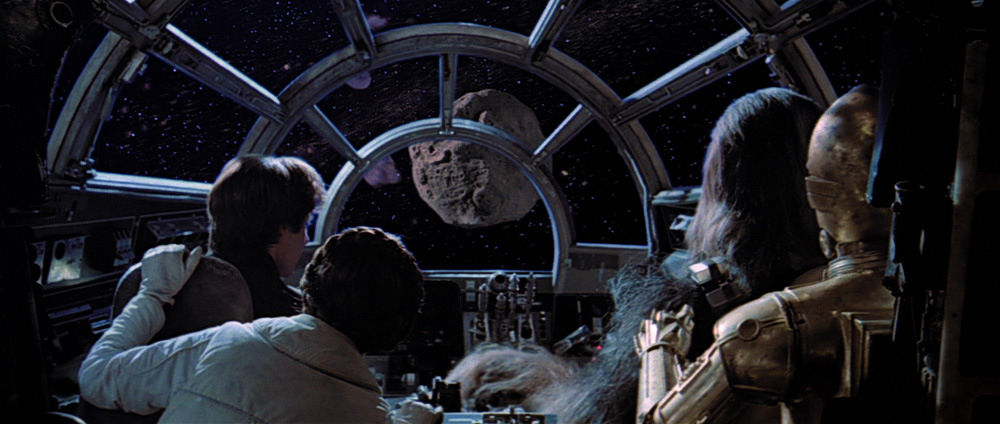
The Hoth asteroid field, which Han Solo improbably and awesomely navigates, is chock full of asteroids that contain valuable minerals and materials, including platinum. While I doubt there are any exogorths (space slugs) or mynocks (the winged parasites that live on the slugs–but you all knew that, right?) on these asteroids, the centrality and value of these celestial rocks in the Star Wars universe is not mere science fiction. Neither is the scenario in Leviathan Wakes, a book by James S. A. Corey and now a Syfy series called The Expanse, in which people have colonized the solar system and set up mining stations on asteroids.
In November, President Obama signed the Asteroid Resources Property Rights Act, which allows Americans to mine asteroids and to own or sell the materials they get. Planetary Resources started billing itself years ago as “the asteroid mining company” and believes asteroid mining will become a reality within the next decade. The Star Wars lore regarding asteroids is accurate—they are indeed hugely valuable. Some contain vast quantities of water, which Planetary Resources hopes to convert into rocket fuel, but even more profitable than that are metals, such as gold and iron, and the most lucrative element of all: platinum. While the existence of an all-platinum asteroid hasn’t been substantiated, we know there are asteroids with millions of tons of platinum out there, and they’re worth trillions of dollars.

So…how exactly will we go about mining asteroids?
The first step is identifying them. Most asteroids live in the belt between Mars and Jupiter (asteroids closer to Earth usually are comprised of rock and are the least valuable type). Satellites such as Planetary Resources crowd-funded ARKYD will allow companies to target asteroids they want to mine.
There are a few different strategies for asteroid mining, the most predictable of which involves having a robotic miner harvest the desired material. But scientists are also considering using rockets to tow asteroids into Earth’s orbit or even bagging them up for easier hauling, or for concentrating sunlight to heat them up, making it easier to excavate water and other material. Some scientists think that near-Earth asteroids would be great fueling and supply stations.
Taking another cue from sci-fi, scientists have realized that—at least theoretically—we can manipulate asteroids a fair bit. NASA’s Near Earth Object Program has a number of strategies to search for near-Earth comets and asteroids, such as its Wide-field Infrared Survey Explorer spacecraft NEOWISE. The ESA is involved in the hunt as well with its Asteroid Impact Mission, as is JAXA with its asteroid-hunting probe Hayabusa-2. NASA even crowd-sourced some asteroid-hunting programs earlier this year.
These agencies are keeping their eyes out not for metal-rich asteroids (though I have to wonder if that’s in the cards going forward), but for ones that might be on a collision course with Earth. In that case, the Armageddon strategy—nuking an asteroid before it hits—is a possibility. But such detonations come with serious risks, including launching pieces of rock in all directions at top speeds, which could wreak havoc on space stations, spacecraft, and/or satellites, and could potentially send two huge rocks down to Earth, ala Deep Impact. Thus, scientists are now working on ways to deflect or move asteroids, a technique that could prove useful not just for safety, but also for mining. And the best part? We may be able to do it with lasers.
The Directed Energy System for Targeting of Asteroids and exploRation, otherwise known as DE-STAR, could, according to simulations, stop an asteroid from spinning or move it in a certain direction. Laser ablation involves irradiating an object with a laser beam, causing some of the asteroid’s mass to vaporize, which then triggers a mass ejection that causes thrust and propulsion—theoretically, enough to alter an asteroid’s course. This could be used to steer an asteroid away from Earth, or it could be used to push an asteroid—say, a smaller, platinum-laden one—closer to Earth for easier and cheaper mining. Of course, the process of deflecting or harnessing an asteroid is expensive and potentially dangerous, but no risk no reward, as they say.
The technological feasibility of mining asteroids is only one hurdle to overcome. What happens next is in many ways a bigger and more complicated question. In Star Wars and in Leviathan Wakes, asteroids and the resources they offer also breed criminal activity and conflict, which I fear may be inevitable in the near future as companies and countries vie for resources. But who knows how this will all play out? As a wise man once said, “Never tell me the odds. “
Never Tell Me the Odds on Disney Video
